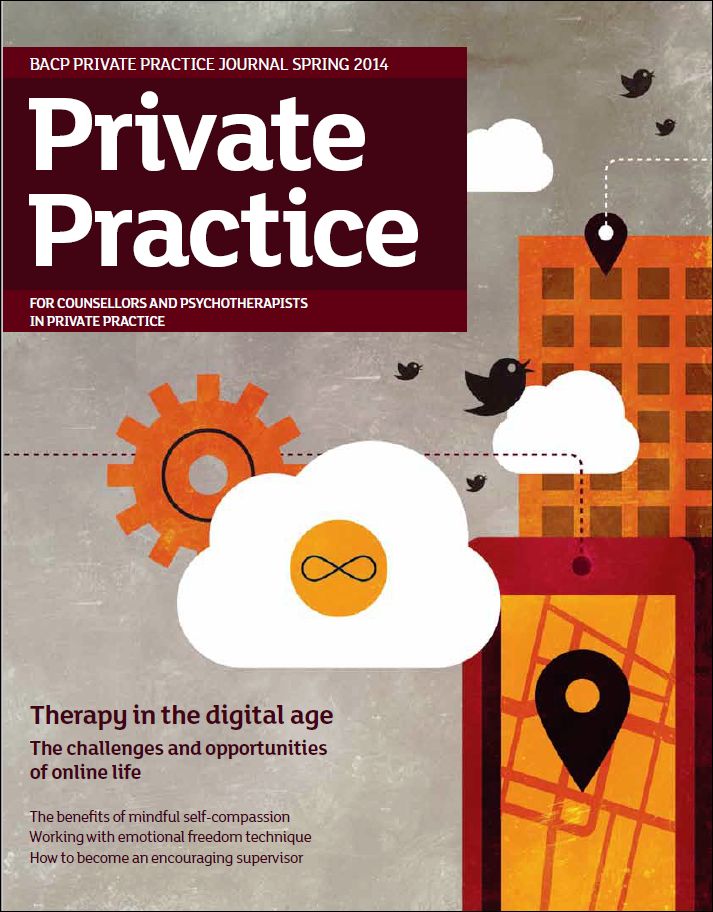In this issue
Features
My practice
New horizons
Claire Thomas has been connecting with a wider community of therapists online
Business matters
More bang for your buck
Martin Hogg on how to get the best results from your marketing spend
Ask an expert
Setting the frame
Heather Dale suggests it’s in the client and therapist’s best interests to issue a written contract
My perspective
Therapy in the digital age
Aaron Balick on the challenges and opportunities of online life
My perspective
The gift of time
Trudi Dargan wonders whether the loss of human contact may be one of the biggest social dilemmas of our time
Practice matters
Being kind to yourself
Julia Bueno on the therapeutic benefits of self-compassion
My story
Killing me softly
Viv Fogel invites a therapist to share how emotional freedom technique helped shift a lifetime of physical pain
Supervision
Becoming an encouraging supervisor
Anthea Millar, Jim Holloway and Penny Henderson on the importance of encouragement in supervision
Regulars
From the chair
James Rye: Take heart

All the articles from the issue are not yet available online. Divisional members and subscribers can download the pdf from the Private Practice archive.
From the editor
My guess is that almost all prospective clients looking for a therapist in private practice will start their search with Google. Turn the clock back just 15 to 20 years and this would not have been the case.
In the time before the internet became a ubiquitous means of mass communication, potential infringements of the therapeutic frame – so sacrosanct to our work – were restricted to the rare incidents in which we might encounter our clients outside of the consulting room. Now there is a whole new domain in which potential or existing clients can happen upon us. This is the world of digital culture, which encompasses all manner of life online and which has expanded exponentially in the last decade into the realm of social media – of which Facebook, LinkedIn, Twitter and YouTube are the most popular.
Those of us born before 1980 (which I guess will be the vast majority) are late arrivals to this world, known to the pundits as ‘digital immigrants’. We will tend to have adopted new technologies after they’ve been in use for some time. Many of our clients, however, are ‘digital natives’: those in their mid-30s and younger who have grown up in the digital age and are less likely to distinguish between online and offline life than the rest of us.
As Aaron Balick, the author of The Psychodynamics of Social Networking, writes in our cover story, digital technology has important implications for our profession. Rather than seeing it as antithetical to the interests of psychotherapy, Aaron contends that advances digital technology fall in line with humanity’s hardwired drive to relate to others and that our clients’ online lives are as open to interpretation as their internal ones.
Crucially, Aaron argues that those of us who engage with technology as part of our work (from using email and Skype to working exclusively online) need to think carefully about how we do this. And those who don’t, still need to think about how we are represented online and how this affects our relationships with clients. Aaron believes it is incumbent on us all to have an online policy and invites those who don’t to use his own policy as a model.
Heather Dale, who contributes our regular ‘Ask an expert’ column to this issue, also recommends, at the very least, the inclusion of a social networking policy when contracting with clients. She makes a strong case for the benefits of issuing a written contract that establishes the ‘rules’ for the therapeutic encounter, arguing that it offers safety for both sides. I am interested in your views on this and any other topic in this issue, or of current relevance to you in your practice, and would love to hear from you at the email address below.
Personally, I am very aware at present of the isolation and insecurity of being in private practice, which James Rye picks up on in this issue’s ‘From the Chair’ when he says we have much in common with actors in that we are only as financially secure as the last client session and work can easily disappear at a moment’s notice. Talking to Julia Bueno, Christopher Germer, the US pioneer, along with Kristin Neff, of mindful self-compassion, says he has often thought that therapists suffer more from self-doubt than other professionals. His words resonate with me, as does Julia’s musing that this may be because what we offer – inner awareness and empathic attunement – are invisible and intangible, and vary with each therapeutic relationship.
Indeed, it could be said that ours is an anxious profession – we work with and contain both our clients’ anxiety and our own. Mindful self-compassion, as taught by Germer and Neff – the cultivation of warmth and understanding in the face of failures, suffering and feelings of inadequacy – seems to me to provide a potentially powerful tool for dealing with difficult emotions. For those of you interested in exploring further ways of working with anxiety, booking is now open for our annual conference, titled ‘Anxiety: How can therapy help?’
Finally, you will notice that we introduce a new ‘refreshed’ look to the journal this issue. I hope you like it. Please let me know what you think.
John Daniel
Editor
privatepractice.editorial@bacp.co.uk
